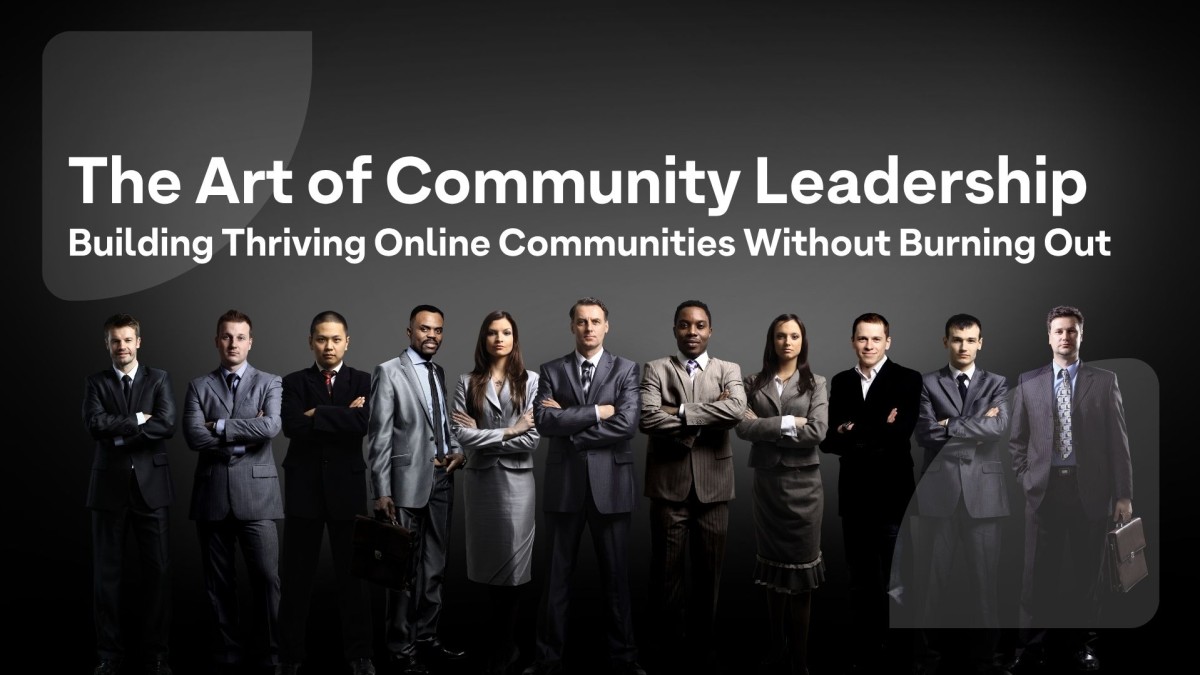The Art of Community Leadership: Building Thriving Online Communities Without Burning Out

You know that feeling when you first launch your online community? The excitement of creating something meaningful, bringing people together,
But then reality hits. Members aren't engaging the way you hoped. Questions pile up faster than you can answer them. And suddenly, you're checking your community at all hours, feeling responsible for every conversation, every silence, every success and failure.
If this sounds familiar, you're not alone. Community leadership isn't just about having the coolest Facebook group or the most members – it's about understanding what it truly means to guide, nurture, and sustain a space where people genuinely want to belong.
See the Live we streamed for this event
The Hidden Reality Behind Community Growth
Here's something most people don't realise: 76% of internet users participate in an online community, yet the vast majority of these communities struggle with engagement and retention. The numbers tell a compelling story – the longer an association has invested in its community, the higher the engagement rates. This isn't coincidence; it's evidence that authentic community leadership takes time, consistency, and a fundamentally different approach than most people expect.
The community engagement platform market alone is worth USD 581.2 million in 2024 and is projected to grow at a staggering 16.20% annually. But here's the catch – having the platform is the easy part. Creating a space where people actually want to engage? That's where most community leaders struggle.
Redefining What Leadership Actually Means
Let's get one thing straight: you're not a guru, manager, or customer service representative. You're a host. Think about the best party you've ever attended. The host wasn't micromanaging every conversation or desperately trying to be the center of attention. They were making sure everyone felt welcome, introducing people with common interests, and quietly handling any issues that arose.
This distinction matters more than you might think. Managing implies control and hierarchy. Leading implies guidance and collaboration. When you try to manage a community, you end up exhausted, controlling every detail, and ultimately creating dependency rather than empowerment.
Real community leadership means setting the tone without dominating the conversation. It's about being visible without being constantly available. It's about creating emotional safety where people feel comfortable sharing their vulnerabilities, mistakes, and successes.
The Engagement Paradox Nobody Talks About
Here's what's fascinating about community engagement: customers spend 19% more time after joining an online community compared to third-party sites like Facebook. People crave authentic connection and meaningful interaction. Yet 55% of community professionals report that consistently keeping members engaged is their top frustration.
Why this disconnect? Because most community leaders focus on the wrong metrics. They obsess over member counts and post frequency instead of relationship quality and value creation. They try to manufacture engagement instead of cultivating the conditions where engagement naturally occurs.
The secret sauce isn't posting more content or sending more notifications. It's understanding why people join versus why they stay. People might join for the content, the expertise, or the promise of solving a problem. But they stay for the connections, the sense of belonging, and the culture you've helped create.
The Burnout Crisis Nobody's Addressing
Here's the uncomfortable truth about community leadership: 77 percent of professionals say they have experienced employee burnout at their current job, and community leaders are particularly vulnerable. The always-on nature of online communities, combined with the emotional labor of supporting community members, creates a perfect storm for exhaustion.
The statistics are sobering. More than 50% of managers report feeling burned out, and community managers face similar challenges. You're expected to be constantly available, endlessly patient, and perpetually positive. It's unsustainable, and it's killing the passion that drew you to community building in the first place.
But here's what successful community leaders understand: being constantly available doesn't create better communities. It creates dependency, reduces member-to-member interaction, and leads directly to burnout. The most thriving communities are those where the leader has learned to step back strategically.
Setting Boundaries That Actually Work
Effective community leadership requires clear boundaries, not just for your sanity, but for the health of your community. When you're always the first to respond, members stop responding to each other. When you're available 24/7, you prevent your community from developing its own rhythm and culture.
Consider this approach: define specific hours when you're actively monitoring your community, but make these windows strategic rather than constant. Maybe you check in during morning coffee, at lunch, and before dinner. This gives you three touchpoints throughout the day while preserving your time for deep work and personal life.
Create different communication channels with different response expectations. Pin comprehensive FAQs. Use community announcements to maintain presence during busy periods. Most importantly, learn to say "that's outside the scope of what we do here" without guilt or extensive explanation.
The Power of Authentic Human Connection
In an age of AI and automation, the most successful communities are those that embrace the messy, imperfect humanity of their leaders and members. Members who engage in community-oriented behavior expect brands to be reliable (57%), trendy/cool (36%), funny (29%), exclusive (29%), and bold (27%).
Notice what's not on that list? Perfect. Professional. Polished.
Share your mistakes. Post casual, unpolished updates. Tell relevant personal stories. Show the human behind the expert. When community members see you as a real person who struggles, learns, and grows, they're more likely to engage authentically themselves.
This doesn't mean oversharing or making your community about you. It means modeling the vulnerability and authenticity you want to see from your members.
Creating Systems That Scale
Smart community leaders build systems that work whether they're online or off. 88% of organisations have at least one dedicated community manager, but if you're running a smaller operation, you need to think strategically about scaling your presence.
Consider creating a bank of post types that drive different kinds of engagement: open-ended questions for discussion, accountability threads for momentum, expertise showcases for member spotlighting, and behind-the-scenes content for connection. Rotate through these strategically rather than constantly creating new content from scratch.
Identify your most helpful, positive members and gradually give them more leadership opportunities. 66% of brand communities define their purpose as relationship building, and peer-to-peer relationships are the foundation of sustainable communities.
The Long Game of Community Building
Building a thriving community isn't a sprint; it's a marathon with no finish line. 28% of online communities have existed for more than 5 years, and this number has grown to 49% by 2021. The communities that survive and thrive are those led by people who understand that consistency beats intensity every time.
This means showing up regularly, not constantly. It means being present, not perfect. It means leading with community needs in mind, not just pushing your own agenda.
Your community will have quiet periods. Members will come and go. Conversations will sometimes fall flat. This is normal, not failure. The key is maintaining the culture and standards you've established while allowing the community to evolve organically.
Beyond the Numbers: What Really Matters
At the end of the day, successful community leadership isn't measured by member counts or post engagement rates. It's measured by the relationships formed, the problems solved, the knowledge shared, and the sense of belonging created.
When members start referring to it as "their" community rather than "your" community, you've succeeded. When they help each other without prompting, you've succeeded. When they feel comfortable being vulnerable and authentic, you've succeeded.
The path to authentic community leadership starts with understanding that you're not building an audience – you're cultivating a culture. You're not managing people – you're facilitating connections. You're not the star of the show – you're the host who makes everyone else shine.
Remember, even the most experienced community leaders make mistakes, face challenging situations, and sometimes feel overwhelmed. The difference is they've learned to see these moments as part of the journey rather than signs of failure. They've built systems, set boundaries, and created cultures that can weather the inevitable ups and downs of community life.
Your community doesn't need a perfect leader. It needs an authentic one who shows up consistently, cares genuinely, and has the wisdom to know when to lead and when to step back. That's the real art of community leadership.
Sources:
Zenler the Course Creators Toolbox. "Community Connections Workshop 12 Session Live Event" May 28th 2025.
https://zenler.co/sell
Bettermode. (2025). 40+ Essential Online Community Stats for 2025. Retrieved from bettermode.com
Higher Logic. (2024). Insights from the 2024 Association Community Benchmark Report. Retrieved from higherlogic.com
Social.Plus. (2024). 40 Statistics You Should Know About Online Communities. Retrieved from social.plus
Cognitive Market Research. (2024). Global Community Engagement Platform Market Report. Retrieved from cognitivemarketresearch.com
BloggingX. (2022). 50+ Online Community Statistics. Retrieved from bloggingx.com
Harvard Business Review. (2023). More Than 50% of Managers Feel Burned Out. Retrieved from hbr.org
Deloitte. (2020). Workplace Burnout Survey. Retrieved from deloitte.com
Ditch the Platform Juggling Act – Scale Your Business the Smart Way
Fed up with tools that don't integrate and subscriptions that add up fast? Zenler consolidates your entire business ecosystem into one powerful platform. Create compelling courses, build active communities, and host professional live events seamlessly.
Your integrated solution:
- Course Architecture: Unlimited content delivery with videos, documents, and interactive elements
- Community Catalyst: Private or public spaces that build loyal, paying audiences
- Live Broadcasting: Native streaming and webinar tools for authentic engagement
- Revenue Optimization: Multi-channel monetization with automated marketing workflows
The advantage? Cohesive systems that amplify each other's impact, not compete for your attention.
Ready to integrate and accelerate? Start Your Free Trial at Zenler.co/sell →
Join thousands who've simplified their path to seven figures.
Categories: : Zenler Marketing Help/Advice
Copyright © 2025 Zenler. All rights reserved.
Terms | Privacy Policy | Cookie Policy | Support
 David Zenler
David Zenler 
